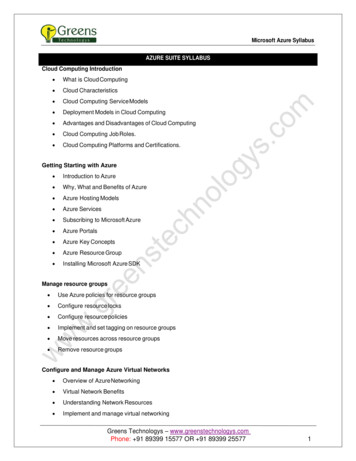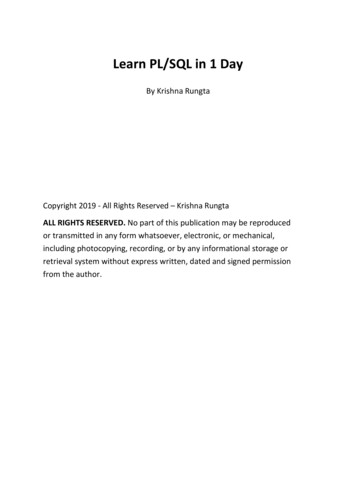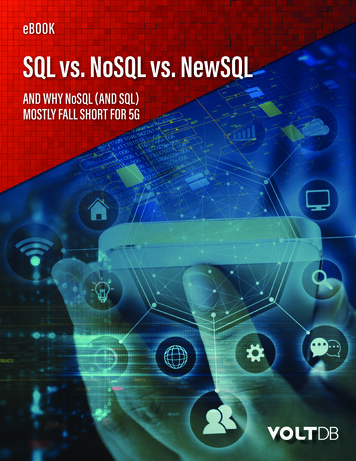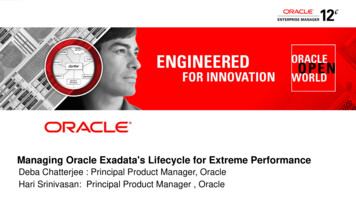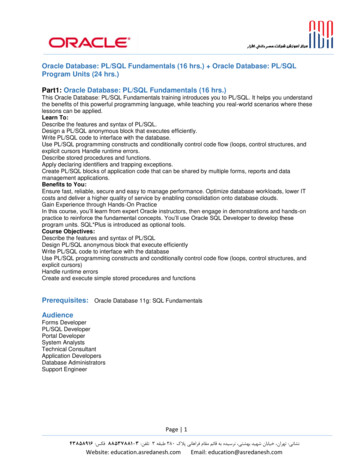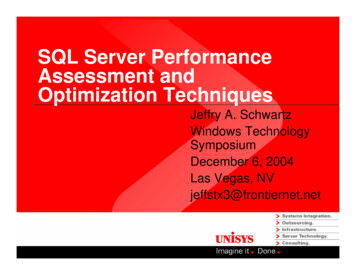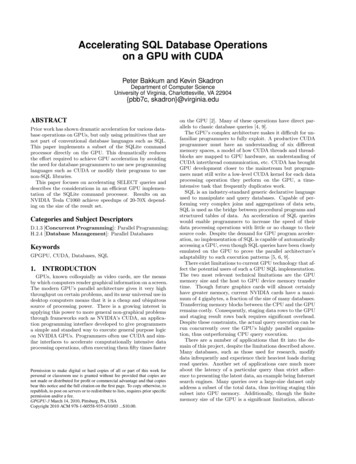
Transcription
Accelerating SQL Database Operationson a GPU with CUDAPeter Bakkum and Kevin SkadronDepartment of Computer ScienceUniversity of Virginia, Charlottesville, VA 22904{pbb7c, skadron}@virginia.eduABSTRACTPrior work has shown dramatic acceleration for various database operations on GPUs, but only using primitives that arenot part of conventional database languages such as SQL.This paper implements a subset of the SQLite commandprocessor directly on the GPU. This dramatically reducesthe effort required to achieve GPU acceleration by avoidingthe need for database programmers to use new programminglanguages such as CUDA or modify their programs to usenon-SQL libraries.This paper focuses on accelerating SELECT queries anddescribes the considerations in an efficient GPU implementation of the SQLite command processor. Results on anNVIDIA Tesla C1060 achieve speedups of 20-70X depending on the size of the result set.Categories and Subject DescriptorsD.1.3 [Concurrent Programming]: Parallel Programming;H.2.4 [Database Management]: Parallel DatabasesKeywordsGPGPU, CUDA, Databases, SQL1.INTRODUCTIONGPUs, known colloquially as video cards, are the meansby which computers render graphical information on a screen.The modern GPU’s parallel architecture gives it very highthroughput on certain problems, and its near universal use indesktop computers means that it is a cheap and ubiquitoussource of processing power. There is a growing interest inapplying this power to more general non-graphical problemsthrough frameworks such as NVIDIA’s CUDA, an application programming interface developed to give programmersa simple and standard way to execute general purpose logicon NVIDIA GPUs. Programmers often use CUDA and similar interfaces to accelerate computationally intensive dataprocessing operations, often executing them fifty times fasterPermission to make digital or hard copies of all or part of this work forpersonal or classroom use is granted without fee provided that copies arenot made or distributed for profit or commercial advantage and that copiesbear this notice and the full citation on the first page. To copy otherwise, torepublish, to post on servers or to redistribute to lists, requires prior specificpermission and/or a fee.GPGPU-3 March 14, 2010, Pittsburg, PA, USACopyright 2010 ACM 978-1-60558-935-0/10/03 . 10.00.on the GPU [2]. Many of these operations have direct parallels to classic database queries [4, 9].The GPU’s complex architecture makes it difficult for unfamiliar programmers to fully exploit. A productive CUDAprogrammer must have an understanding of six differentmemory spaces, a model of how CUDA threads and threadblocks are mapped to GPU hardware, an understanding ofCUDA interthread communication, etc. CUDA has broughtGPU development closer to the mainstream but programmers must still write a low-level CUDA kernel for each dataprocessing operation they perform on the GPU, a timeintensive task that frequently duplicates work.SQL is an industry-standard generic declarative languageused to manipulate and query databases. Capable of performing very complex joins and aggregations of data sets,SQL is used as the bridge between procedural programs andstructured tables of data. An acceleration of SQL querieswould enable programmers to increase the speed of theirdata processing operations with little or no change to theirsource code. Despite the demand for GPU program acceleration, no implementation of SQL is capable of automaticallyaccessing a GPU, even though SQL queries have been closelyemulated on the GPU to prove the parallel architecture’sadaptability to such execution patterns [5, 6, 9].There exist limitations to current GPU technology that affect the potential users of such a GPU SQL implementation.The two most relevant technical limitations are the GPUmemory size and the host to GPU device memory transfertime. Though future graphics cards will almost certainlyhave greater memory, current NVIDIA cards have a maximum of 4 gigabytes, a fraction of the size of many databases.Transferring memory blocks between the CPU and the GPUremains costly. Consequently, staging data rows to the GPUand staging result rows back requires significant overhead.Despite these constraints, the actual query execution can berun concurrently over the GPU’s highly parallel organization, thus outperforming CPU query execution.There are a number of applications that fit into the domain of this project, despite the limitations described above.Many databases, such as those used for research, modifydata infrequently and experience their heaviest loads duringread queries. Another set of applications care much moreabout the latency of a particular query than strict adherence to presenting the latest data, an example being Internetsearch engines. Many queries over a large-size dataset onlyaddress a subset of the total data, thus inviting staging thissubset into GPU memory. Additionally, though the finitememory size of the GPU is a significant limitation, allocat-
ing just half of the 4 gigabytes of a Tesla C1060 to store adata set gives the user room for over 134 million rows of 4integers.The contribution of this paper is to implement and demonstrate a SQL interface for GPU data processing. This interface enables a subset of SQL SELECT queries on datathat has been explicitly transferred in row-column form toGPU memory. SELECT queries were chosen since they arethe most common SQL query, and their read-only characteristic exploits the throughput of the GPU to the highest extent. The project is built upon an existing opensource database, SQLite, enabling switching between CPUand GPU query execution and providing a direct comparison of serial and parallel execution. While previous researchhas used data processing primitives to approximate the actions of SQL database queries, this implementation is builtfrom the ground up around the parsing of SQL queries, andthus executes with significant differences.In this context, SQL allows the programmer to drasticallychange the data processing patterns executed on the GPUwith the smallest possible development time, literally producing completely orthogonal queries with a few changes inSQL syntax. Not only does this simplify GPU data processing, but the results of this paper show that executing SQLqueries on GPU hardware significantly outperforms serialCPU execution. Of the thirteen SQL queries tested in thispaper, the smallest GPU speedup was 20X, with a mean of35X. These results suggest this will be a very fruitful areafor future research and development.2.RELATED WORK2.1GPU Data MiningThere has been extensive research in general data mining on GPUs, thoroughly proving its power and the advantages of offloading processing from the CPU. The researchrelevant to this paper focuses on demonstrating that certain database operations, (i.e. operations that are logicallyperformed within a database during a query execution) canbe sped up on GPUs. These projects are implemented using primitives such as Sort and Scatter, that can be combined and run in succession on the same data to producethe results of common database queries. One paper dividesdatabase queries into predicate evaluation, boolean combination, and aggregation functions [9]. Other primitives include binary searches, p-ary searches [14], tree operations,relational join operations [6], etc. An area where GPUs haveproven particularly useful is with sort operations. GPUTeraSort, for example, is an algorithm developed to sort databaserows based on keys, and demonstrated significant performance improvements over serial sorting methods [8]. Oneof the most general of the primitive-based implementationsis GPUMiner, a program which implements several algorithms, including k-means, and provides tools to visualizethe results [7]. Much of this research was performed on previous generations of GPU hardware, and recent advancescan only improve the already impressive results.One avenue of research directly related to production SQLdatabases is the development of database procedures thatemploy GPU hardware. These procedures are written by theuser and called through the database to perform a specificfunction. It has been shown using stored and external procedures on Oracle [1] PostgreSQL databases [13] that GPUfunctionality can be exploited to accelerate certain operations. The novelty of this approach is that CUDA kernelsare accessed through a database rather than explicitly calledby a user program.The most closely related research is Relational Query Coprocessing on Graphics Processors, by Bingsheng He, et al.[12]. This is a culmination of much of the previous researchperformed on GPU-based data processing. Its authors design a database, called GDB, accessed through a plethoraof individual operations. These operations are divided intooperators, access methods, and primitives. The operators include ordering, grouping, and joining functionality. The access methods control how the data is located in the database,and includes scanning, trees, and hashing. Finally the primitives are a set of functional programming operations such asmap, reduce, scatter, gather, and split. GDB has a numberof similarities to the implementation described in this paper,notably the read-only system and column-row data organization, but lacks direct SQL access. In the paper, severalSQL queries are constructed with the primitives and benchmarked, but no parser exists to transform SQL queries tosequences of primitives.This paper’s implementation has similar results to the previous research, but approaches the querying of datasets froman opposing direction. Other research has built GPU computing primitives from the ground up, then built programswith these primitives to compare to other database operations. This paper’s research begins with the codebase of aCPU-based database and adapts its computational elementsto execute on a GPU. This approach allows a much moredirect comparison with traditional databases, and most importantly, allows the computing power of the GPU to beaccessed directly through SQL. SQL presents a uniform andstandardized interface to the GPU, without knowledge ofthe specific primitives of a certain implementation, and withthe option choosing between CPU and GPU execution. Inother words, the marginal cost of designing data processingqueries to be run on a GPU is significantly reduced with aSQL interface.To our knowledge, no other published research providesthis SQL interface to GPU execution. In practical terms,this approach means that a CUDA thread executes a set ofSQLite opcodes on a single row before exiting, rather thana host function managing bundle of primitives as CUDAkernels. It is possible that a SQL interface to the primitives discussed in other research could be created througha parser, but this has not been done, and may or may notbe more advantageous for GPU execution. Many primitivessuch as sort and group have direct analogs in SQL, futureresearch may clarify how an optimal SQL query processordiffers when targeting the GPU versus the CPU.2.2MapReduceA new and active area of data mining research is in theMapReduce paradigm. Originally pioneered by Google, itgives the programmer a new paradigm for data mining basedon the functional primitives map and reduce [3]. This paradigm has a fundamentally parallel nature, and is used extensively by Google and many other companies for large-scaledistributed data processing. Though essentially just a namefor using two of the primitives mentioned in the previoussection, MapReduce has become a major topic itself. Research in this area has shown that MapReduce frameworks
can be accelerated on multicore machines [16] and on GPUs[11]. Notably, Thrust, a library of algorithms implementedin CUDA intended as a GPU-aware library similar to theC Standard Template Library, includes a MapReduceimplementation [24].In some cases, a MapReduce framework has become a replacement for a traditional SQL database, though its useremains limited. The advantage of one over the other remains a hotly debated topic, both are very general methodsthrough which data can be processed. MapReduce requiresthe programmer to write a specific query procedurally, whileSQL’s power lies in its simple declarative syntax. Consequently, MapReduce most useful for handling unstructureddata. A key difference is that the simplicity of the MapReduce paradigm makes it simple to implement in CUDA,while no such SQL implementation exists. Additionally thelimited use of MapReduce restricts any GPU implementation to a small audience, particularly given that the memoryceilings of modern GPUs inhibit their use in the huge-scaledata processing applications for which MapReduce is known.2.3Programming AbstractionAnother notable vector of research is the effort to simplifythe process of writing GPGPU applications, CUDA applications in particular. Writing optimal CUDA programs requires an understanding of the esoteric aspects of NVIDIAhardware, specifically the memory heirarchy. Research onthis problem has focused on making the heirarchy transparent to the programmer, performing critical optimizationduring compilation. One such project has programmerswrite CUDA programs that exclusively use global memory,then chooses the best variables to move to register memory, shared memory, etc. during the compilation phase [17].Other projects such as CUDA-lite and hiCUDA have theprogrammer annotate their code for the compiler, whichchooses the best memory allocation based on these notes,an approach similar to the OpenMP model [10, 25]. Yetanother project directly translates OpenMP code to CUDA,effectively making it possible to migrate parallel processorcode to the GPU with no input from the programmer [15]. Acommon thread in this area is the tradeoff between the difficulty of program development and the optimality of the finished product. Ultimately, programming directly in CUDAremains the only way to ensure a program is taking full advantage of the GPU hardware.Regardless of the specifics, there is clear interest in providing a simpler interface to GPGPU programming than thosethat currently exist. The ubiquity of SQL and its pervasiveparallelism suggest that a SQL-based GPU interface wouldbe easy for programmers to use and could significantly speedup many applications that have already been developed withdatabases. Such an interface would not be ideal for all applications, and would lack the fine-grained optimization ofthe previously discussed interfaces, but could be significantlysimpler to use.3.3.1SQLITEOverviewSQLite is a completely open source database developed bya small team supported by several major corporations [20].Its development team claims that SQLite is the most widelydeployed database in the world owing to its use in popularapplications, such as Firefox, and on mobile devices, suchas the iPhone [22]. SQLite is respected for its extreme simplicity and extensive testing. Unlike most databases whichoperate as server, accessed by separate processes and usuallyaccessed remotely, SQLite is written to be compiled directlyinto the source code of the client application. SQLite is distributed as a single C source file, making it trivial to adda database with a full SQL implementation to a C/C application.3.2ArchitectureSQLite’s architecture is relatively simple, and a brief description is necessary for understanding the CUDA implementation described in this paper. The core of the SQLiteinfrastructure contains the user interface, the SQL commandprocessor, and the virtual machine [21]. SQLite also containsextensive functionality for handling disk operations, memory allocation, testing, etc. but these areas are less relevantto this project. The user interface consists of a library ofC functions and structures to handle operations such as initializing databases, executing queries, and looking at results.The interface is simple and intuitive: it is possible to opena database and execute a query in just two function calls.Function calls that execute SQL queries use the SQL command processor. The command processor functions exactlylike a compiler: it contains a tokenizer, a parser, and a codegenerator. The parser is created with an LALR(1) parsergenerator called Lemon, very similar to YACC and Bison.The command processor outputs a program in an intermediate language similar to assembly. Essentially, the commandprocessor takes the complex syntax of a SQL query and outputs a set of discrete steps.Each operation in this intermediate program contains anopcode and up to five arguments. Each opcode refers to aspecific operation performed within the database. Opcodesperform operations such as opening a table, loading datafrom a cell into a register, performing a math operation ona register, and jumping to another opcode [23]. A simpleSELECT query works by initializing access to a databasetable, looping over each row, then cleaning up and exiting.The loop includes opcodes such as Column, which loads datafrom a column of the current row and places it in a register,ResultRow, which moves the data in a set of registers to theresult set of the query, and Next, which moves the programon to the next row.This opcode program is executed by the SQLite virtualmachine. The virtual machine manages the open databaseand table, and stores information in a set of ”registers”,which should not be confused with the register memory ofCUDA. When executing a program, the virtual machine directs control flow through a large switch statement, whichjumps to a block of code based on the current opcode.3.3UsefulnessSQLite was chosen as a component of this project for anumber of reasons. First, using elements of a well-developeddatabase removes the burden of having to implement SQLquery processing for the purposes of this project. SQLitewas attractive primarily for its simplicity, having been developed from the ground up to be as simple and compactas possible. The source code is very readable, written in aclean style and commented heavily. The serverless design ofSQLite also makes it ideal for research use. It is very easy
to modify and add code and recompile quickly to test, andits functionality is much more accessible to someone interested in comparing native SQL query execution to execution on the GPU. Additionally, the SQLite source code is inthe public domain, thus there are no licensing requirementsor restrictions on use. Finally, the widespread adoption ofSQLite makes this project relevant to the industry, demonstrating that many already-developed SQLite applicationscould improve their performance by investing in GPU hardware and changing a trivial amount of code.From an architectural standpoint, SQLite is useful for itsrigid compartmentalization. Its command processor is entirely separate from the virtual machine, which is entirelyseparate from the disk i/o code and the memory allocation code, such that any of these pieces can be swappedout for custom code. Critically, this makes it possible to reimplement the virtual machine to run the opcode programon GPU hardware.A limitation of SQLite is that its serverless design means itis not implemented to take advantage of multiple cores. Because it exists solely as a part of another program’s process,threading is controlled entirely outside SQLite, though it hasbeen written to be thread-safe. This limitation means thatthere is no simple way to compare SQLite queries executedon a single core to SQLite queries optimized for multicoremachines. This is an area for future work.4.4.1IMPLEMENTATIONScopeGiven the range of both database queries and database applications and the limitations of CUDA development, it isnecessary to define the scope of of this project. We explicitlytarget applications that run SELECT queries multiple timeson the same mid-size data set. The SELECT query qualification means that the GPU is used for read-only data. Thisenables the GPU to maximize its bandwidth for this caseand predicates storing database rows in row-column form.The ’multiple times’ qualification means that the project hasbeen designed such that SQL queries are executed on dataalready resident on the card. A major bottleneck to GPUdata processing is the cost of moving data between deviceand host memory. By moving a block of data into the GPUmemory and executing multiple queries, the cost of loadingdata is effectively amortized as we execute more and morequeries, thus the cost is mostly ignored. Finally, a ’mid-sizedata set’ is enough data to ignore the overhead of settingup and calling a CUDA kernel but less than the ceiling oftotal GPU memory. In practice, this project was designedand tested using one and five million row data sets.This project only implements support for numeric datatypes. Though string and blob types are certainly very useful elements of SQL, in practice serious data mining on unstructured data is often easier to implement with anotherparadigm. Strings also break the fixed-column width dataarrangement used for this project, and transferring character pointers from the host to device is a tedious operation.The numeric data types supported include 32 bit integers,32 bit IEEE 754 floating point values, 64 bit integers, and64 bit IEEE 754 double precision values. Relaxing these restrictions is an area for future work.4.2Data SetAs previously described, this project assumes data staysresident on the card across multiple queries and thus neglects the up-front cost of moving data to the GPU. Basedon the read-only nature of the SQL queries in this projectand the characteristics of the CUDA programming model,data is stored on the GPU in row-column form. SQLitestores its data in a B-Tree, thus an explicit translation stepis required. For convenience, this process is performed witha SELECT query in SQLite to retrieve a subset of data fromthe currently open database.The Tesla C1060 GPU used for development has 4 gigabytes of global memory, thus setting the upper limit ofdata set size without moving data on and off the card during query execution. Note that in addition to the data setloaded on the GPU, there must be another memory blockallocated to store the result set. Both of these blocks are allocated during the initialization of the program. In additionto allocation, meta data such as the size of the block, thenumber of rows in the block, the stride of the block, and thesize of each column must be explicitly managed.4.3Memory SpacesThis project attempts to utilize the memory heirarchy ofthe CUDA programming model to its full extent, employing register, shared, constant, local, and global memory [19].Register memory holds thread-specific memory such as offsets in the data and results blocks. Shared memory, memory shared among all threads in the thread block, is usedto coordinate threads during the reduction phase of the kernel execution, in which each thread with a result row mustemit that to a unique location in the result data set. Constant memory is particularly useful for this project sinceit is used to store the opcode program executed by everythread. It is also used to store data set meta information,including column types and widths. Since the program andthis data set information is accessed very frequently acrossall threads, constant memory significantly reduces the overhead that would be incurred if this information was storedin global memory.Global memory is necessarily used to store the data seton which the query is being performed. Global memory hassignificantly higher latency than register or constant memory, thus no information other than the entire data set isstored in global memory, with one esoteric exception. Localmemory is an abstraction in the CUDA programming modelthat means memory within the scope of a single thread thatis stored in the global memory space. Each CUDA threadblock is limited to 16 kilobytes of register memory: when thislimit broken the compiler automatically places variables inlocal memory. Local memory is also used for arrays thatare accessed by variables not known at compile time. Thisis a significant limitation since the SQLite virtual machineregisters are stored in an array. This limitation is discussedin further detail below.Note that texture memory is not used for data set access.Texture memory acts as a one to three dimensional cachefor accessing global memory and can significantly acceleratecertain applications[19]. Experimentation determined thatusing texture memory had no effect on query performance.There are several reasons for this. First, the global data setis accessed relatively infrequently, data is loaded into SQLiteregisters before it is manipulated. Next, texture memory
is optimized for two dimensional caching, while the dataset is accessed as one dimensional data in a single block ofmemory. Finally, the row-column data format enables mostglobal memory accesses to be coalesced, reducing the needfor caching.4.4Parsed QueriesAs discussed above, SQLite parses a SQL query into anopcode program that resembles assembly code. This projectcalls the SQLite command processor and extracts the results, removing data superfluous to the subset of SQL queriesimplemented in this project. A processing phase is also usedto ready the opcode program for transfer to the GPU, including dereferencing pointers and storing the target directlyin the opcode program. A sample program is printed below,output by the command processor for query 1 in AppendixA.0:Trace0001:Integer60 102:Integer0203:Goto017 04:OpenRead0205:Rewind015 06:Column0137:Le114 38:Column0239:Ge214 310: Column00511: Column01612: Column02713: ResultRow53014: Next06015: Close00016: Halt00017: Transaction00018: VerifyCookie 01019: TableLock02020: Goto040A virtual machine execution of this opcode procedure iterates sequentially over the entire table and emits result rows.Note that not all of the opcodes are relevant to this project’sstorage of a single table in GPU memory, and are thus notimplemented. The key to this kind of procedure is thatopcodes manipulate the program counter and jump to different locations, thus opcodes are not always executed inorder. The Next opcode, for example, advances from onerow to the next and jumps to the value of the second argument. An examination of the procedure thus reveals theblock of opcodes 6 through 14 are executed for each row ofthe table. The procedure is thus inherently parallelizableby assigning each row to a CUDA thread and executing thelooped procedure until the Next opcode.Nearly all opcodes manipulate the array of SQLite registers in some way. The registers are generic memory cellsthat can store any kind of data and are indexed in an array.The Column opcode is responsible for loading data from acolumn in the current row into a certain register.Note the differences between a program of this kind anda procedure of primitives, as implemented in previous research. Primitives are individual CUDA kernels executedserially, while the entire opcode procedure is executed entirely within a kernel. As divergence is created based onthe data content of each row, the kernels execute differentopcodes. This type of divergence does not occur with aquery-plan of primitives.4.5Virtual Machine InfrastructureThe crux of this project is the reimplementation of theSQLite virtual machine with CUDA. The virtual machineis implemented as a CUDA kernel that executes the opcode procedure. The project has implemented around 40opcodes thus far which cover the comparison opcodes, suchas Ge (greater than or equal), the mathematical opcodes,such as Add, the logical opcodes, such as Or, the bitwiseopcodes, such as BitAnd, and several other critical opcodessuch as ResultRow. The opcodes are stored in two switchstatements.The first switch statement of the virtual machine allowsdivergent opcode execution, while the second requires concurrent opcode execution. In other words, the first switchstatement allows different threads to execute different opcodes concurrently, and the second does not. When theNext opcode is encountered, signifying the end of the datadependent parallelism, the virtual machine jumps from thedivergent block to the concurrent block. The concurrentblock is used for the aggregation functions, where coordination across all threads is essential.A major piece of the CUDA kernel is the reduction whenthe ResultRow opcode is called by multiple threads to emitrows of results. Since not every thread emits a row, a reduction operation must be performed to ensure that the resultblock is a contiguous set of data. This reduction involvesinter-thread and inter-threadblock communication, as eachthread that needs to emit a row must be assigned a uniquearea of the result set data block. Although the result set iscontiguous, no order of results is guaranteed. This saves themajor overhead of completely synchronizing when threadsand threadblocks complete execution.The reduction is implemented using the CUDA atomicoperation atomicAdd(), called on two tiers. First, eachthread with a result row calls atomicAdd() on a variablein shared memory, thus receiving an assignment within thethread block. The last thread in the block then calls thisfunction on a separate global variable which determine’s thethread block’s position in the memory space, which eachthread then uses to determine its exact target row based onthe previous assignment within the thread block. Experimentation has found that this method of reduction is fasterthan others for this particular type of assigment, particularlywith sparse result sets.This project also supports SQL aggregation functions (i.e.COUNT, SUM, MIN, MAX, and AVG), though only for integer values. Significant effort has been made to adhereto the SQLite-parsed query plan without multiple kernellaunches. Since inter-threadblock coordination, such as thatused for aggregation functions, is difficult without using akernel launch as a global barrier, atomic functio
memory size and the host to GPU device memory transfer time. Though future graphics cards will almost certainly have greater memory, current NVIDIA cards have a maxi-mum of 4 gigabytes, a fraction of the size of many databases. Transferring memory blocks between the CPU and the GPU remains costly. Consequently, staging data rows to the GPU


